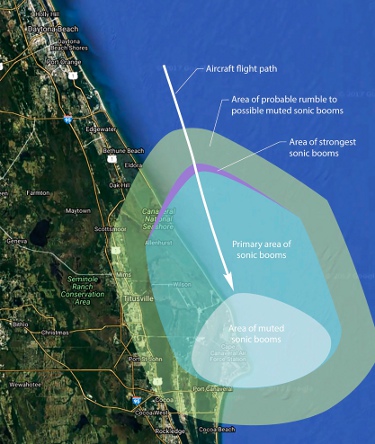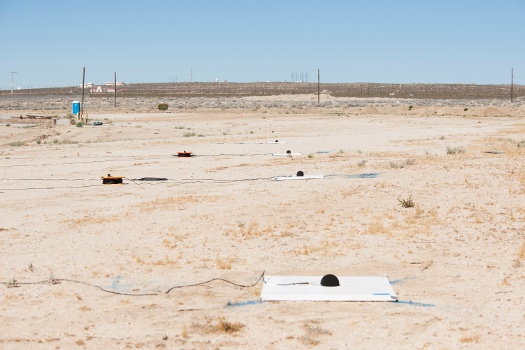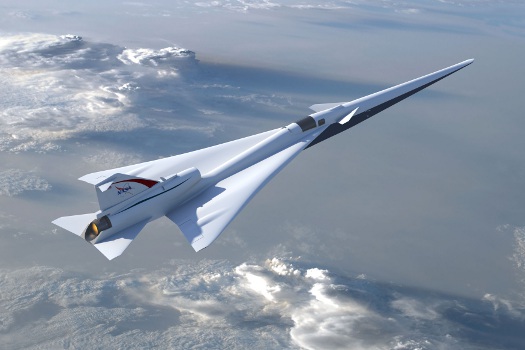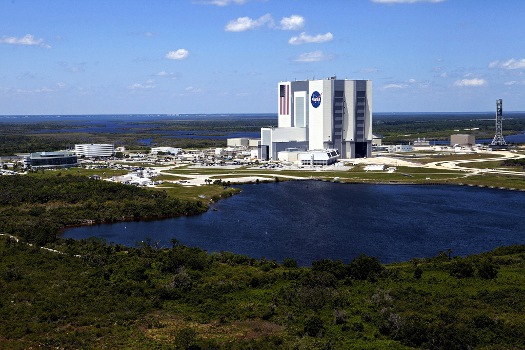 |
| August 08, 2017 | Volume 13 Issue 30 |
Designfax weekly eMagazine
Archives
Partners
Manufacturing Center
Product Spotlight
Modern Applications News
Metalworking Ideas For
Today's Job Shops
Tooling and Production
Strategies for large
metalworking plants
NASA unleashing sonic booms on Florida in bid to study making them quieter
By Bob Granath, NASA's Kennedy Space Center, FL
Residents along Florida's Space Coast will soon hear a familiar sound -- sonic booms. But instead of announcing a spacecraft's return from space, they may herald a new era in faster air travel.
NASA's Kennedy Space Center in Florida is partnering with the agency's Armstrong Flight Research Center in California, Langley Research Center in Virginia, and Space Florida for a program called Sonic Booms in Atmospheric Turbulence, or SonicBAT II. Starting in mid-August, NASA F-18 jets will take off from the Shuttle Landing Facility (SLF) and fly at supersonic speeds while agency researchers on the ground measure the effects of low-altitude turbulence on sonic booms.


NASA will fly an F-18 research aircraft to produce sonic booms over Kennedy Space Center in Florida. The sonic booms will be recorded by equipment both in the air and on the ground, providing NASA researchers with data to help them better understand the impact of atmospheric turbulence on sonic booms. [NASA Photos/(Bottom) Ken Ulbrich]
The project is another example of Kennedy's role as a premier, multi-user spaceport. In 2015, the center signed a 30-year property agreement with Space Florida for the operations and management of the SLF. This partnership provides an avenue for a variety of commercial and government partners to have access to use the three-mile long runway.
According to John Graves of NASA Flight Operations in Kennedy's Spaceport Integration and Services, for projects such as SonicBAT, NASA coordinates with Space Florida who manages the facility's schedule.

NASA's F-18 will fly at or above 32,000 ft when it goes supersonic off the eastern coast of Florida. The F-18's flightpath is positioned in efforts to keep the strongest-sounding sonic booms away from residential areas, while still producing sonic booms over the Kennedy Space Center, where the sonic boom sound will be collected by microphone arrays on the ground. [Credits: NASA]
"Working with representatives from the Armstrong center, we go through Space Florida to request use of the runway," he said. "It's an arrangement that works very well."
The F-18 will begin flights on Aug. 21, flying two to four times a day over a period of 10 days. But the actual test window may be two weeks to allow for weather and other possible delays.
Graves explains that SonicBAT is an unusual test in that it uses a typical military aircraft with its loud sonic boom to help engineers better understand the sounds from future quiet supersonic aircraft.
"We're hoping we can eventually lower sonic booms to a low rumble," he said. "The goal is to eventually accommodate jets that can fly from New York to Los Angeles in two hours."
Armstrong started SonicBAT investigations at Edwards Air Force Base last year. This will be the second round of tests.
"Edwards is a hot, dry environment," he said. "The team at the Armstrong center wants to now try to collect similar data in the hot, humid climate we have here."

One of three microphone arrays positioned strategically along the ground at Edwards Air Force Base, CA, sits ready to collect sound signatures from sonic booms created by a NASA F-18 during the SonicBAT flight series. Similar arrays will be set up near NASA's Kennedy Space Center to collect the sound signatures of booms that have traveled through atmospheric turbulence before reaching the ground. [Credits: NASA/Lauren Hughes]
The problem is sonic booms are bothersome, loud, thunder-like sounds occurring when an aircraft or other aerospace vehicle flies overhead faster than the speed of sound -- about 767 mph. U.S. Air Force pilot Chuck Yeager was the first to break the sound barrier on Oct. 14, 1947, at Muroc (now Edwards) Air Force Base in California.
Throughout the 1950s and 1960s, sonic booms became a familiar part of American life as military jets became faster and faster. At the time, it seemed that supersonic passenger air travel was on the near horizon. However, the boom created by shock waves, or rapid changes in pressure that occur at supersonic speeds, disturbed people and occasionally caused property damage when military aircraft flew at very low altitudes. Consequently, such flights currently are restricted by the Federal Aviation Administration, except for craft such as the now-retired space shuttle, SpaceX Falcon 9 first stages, and the X-37B Orbital Test Vehicle.
"For the upcoming tests, F-18 jets will fly offshore from Daytona at about 41,000 feet," Graves said. "They will fly south, diving down below to around 32,000 feet and accelerating to supersonic speeds to create a sonic boom that will reach the ground where the test equipment is located."
There will be a small motorized glider that can fly with its engine off positioned above the 14,000-ft level to measure sonic booms above the turbulent layer, and microphone sensors set up north and south of Launch Complex 39B.
With this data and building on previous supersonic research, NASA hopes to develop cutting-edge tools and technologies for the design of future "low boom" aircraft reducing or almost eliminating the noise.

This illustration depicts NASA's planned Low Boom Flight Demonstration aircraft. The agency and Lockheed Martin have just completed the preliminary design of the Quiet Supersonic Transport, or QueSST, aircraft studying the shape and position of aircraft components, along with the propulsion system to determine which factors contribute to an aircraft's sonic boom. [Credits: NASA/Lockheed Martin]
The ongoing research goes beyond SonicBAT. NASA and partners in U.S. industry and universities are testing a variety of factors that may make supersonic passenger travel a reality. The next exciting step will be the development of experimental aircraft that can demonstrate low boom flight. NASA and Lockheed Martin have just completed the preliminary design of the Quiet Supersonic Transport, or QueSST, aircraft studying the shape and position of aircraft components, along with the propulsion system to determine what factors contribute to an aircraft's sonic boom.
In the next phase of this effort, NASA will partner with U.S. industry to build the Low Boom Flight Demonstrator, an experimental aircraft that, when flying at supersonic speeds, will create a soft "thump" instead of the disruptive sonic boom.
----------------------------------------------------------
SIDEBAR: More about SonicBAT testing
By Matt Kamlet, NASA Armstrong Flight Research Center
Sonic Booms in Atmospheric Turbulence flights, or SonicBAT, helps NASA researchers better understand how low-altitude atmospheric turbulence affects sonic booms, which are produced when an aircraft flies at supersonic speeds, or faster than the speed of sound. The upcoming flight series is a key initiative in validating tools and models that will be used for the development of future quiet supersonic aircraft, which will produce a soft thump in place of the louder sonic boom.
"In SonicBAT, we're trying to figure out how much atmospheric turbulence changes sonic booms," said Ed Haering, SonicBAT's principal investigator at Armstrong.
The initial series of SonicBAT flights provided NASA with data on the effect of atmospheric turbulence on sonic booms in a dry climate. The upcoming flights will continue that effort by collecting data in the same fashion to measure the effect of the humid climate of Florida.
"Turbulence can make sonic booms quieter, or it can make them louder. Last summer we tested in the hot, dry climate of Edwards Air Force Base. We know that humidity can make sonic booms louder, so we need to test some place wetter, and Kennedy fits that bill," Haering said.

Atmospheric turbulence can influence the way sonic booms reach the ground, but the influences may be different between humid from dry climates. Having performed SonicBAT tests in the dry climate of NASA Armstrong Flight Research Center, located on Edwards Air Force Base in California, testing is ready to continue in a more humid environment. NASA's Kennedy Space Center in Florida will host the second round of SonicBAT flights, providing the ability to perform research flights in humid conditions. [NASA Photo/NASA Kennedy]
Sonic boom signature data will be collected from these tests using audio equipment to capture noise levels both above and below the turbulence layer, which will provide a comparison of the sonic boom both before and after it travels through atmospheric turbulence.
To do this, a NASA Armstrong F-18 will take off from Kennedy's Shuttle Landing Facilty and fly off the coast of Cape Canaveral at an altitude of 32,000 ft. The F-18 will fly a designated flight path where it will exceed Mach 1, the speed of sound, and produce a sonic boom.
Meanwhile, NASA also will fly a TG-14 motorized glider, equipped with a wingtip microphone, at an altitude between 4,000 to 10,000 ft, which is above the low-altitude turbulence layer. At the test point, the TG-14 will temporarily shut down its motor and glide. This will eliminate any unnecessary noise, ensuring that the wingtip microphone will pick up a clean, accurate sonic boom signature before it travels through any turbulence.
To collect signatures of sonic booms that travel through the turbulence layer, NASA, along with partners Wyle Laboratories and Gulfstream Aerospace, will arrange two microphone arrays on the ground at Kennedy, each with 16 microphones to collect data.
The project aims to collect data in three different conditions, including low turbulence, medium turbulence, and significant turbulence, to obtain a stronger understanding of how the variations impact sonic booms. To monitor these conditions, NASA meteorologists will be on-site using anemometers to measure wind speed, a sonic wind profiler to measure wind conditions at low altitude, and a flux sensor to measure changes due to humidity.
NASA is expecting to fly the F-18 two to three times per day, starting Monday, Aug. 21 and will conclude the end of the month or early September, focusing on collecting data on a targeted minimum of 33 sonic booms.
While communities nearby Kennedy and Cape Canaveral Air Force Station may be able to hear traces of the sonic booms being produced over the NASA center, Haering said residents have no reason to worry.
Decades of NASA research in supersonic flight have resulted in a unique aerodynamic design and technological advances for an aircraft that will mitigate the sonic boom, making it considerably quieter.
In February 2016, NASA awarded a contract to Lockheed Martin for a preliminary design of a quiet supersonic X-plane called the Low-Boom Flight Demonstration aircraft, or LBFD. This effort recently completed a successful preliminary design review, and NASA will soon initiate the next phase of the LBFD concept through a new contract competition.
This second phase will focus on the detailed design and fabrication of the aircraft. When completed, the goal will be to fly the X-plane over communities throughout the country to test and demonstrate a quiet sonic thump. These flight tests will also provide data to the FAA for the development of potential noise standards for future supersonic flight over land.
If the FAA establishes that new sound standards based on the sonic boom research has become acceptable to the public, commercial flights that can carry passengers at supersonic speeds, reducing commercial flight times considerably, could be just years away.
Published August 2017
Rate this article
View our terms of use and privacy policy
